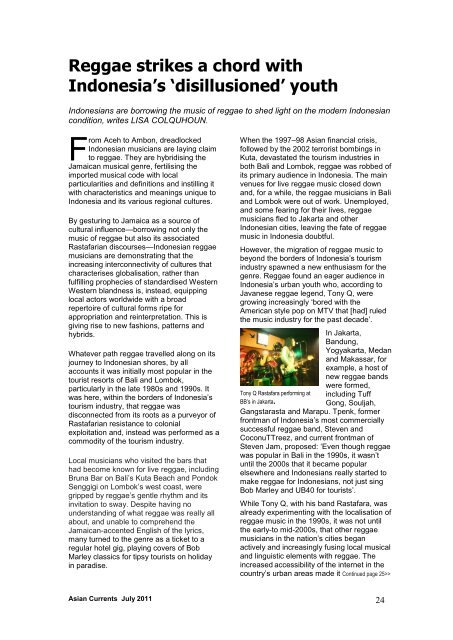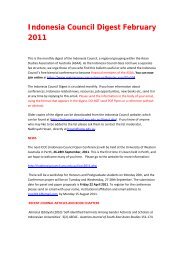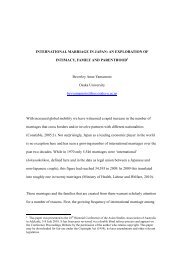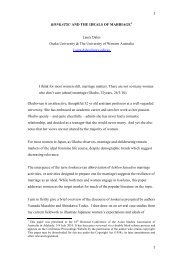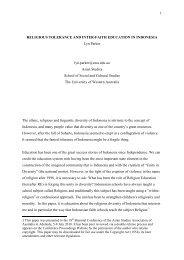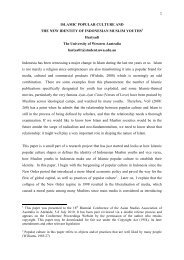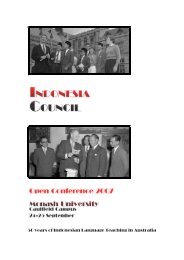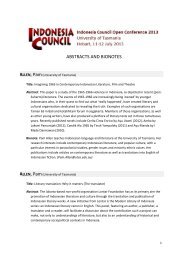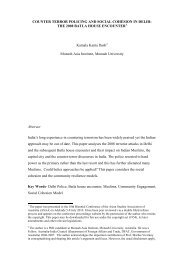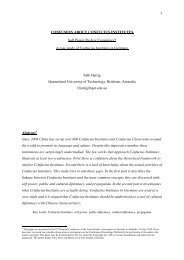Asian Currents - Asian Studies Association of Australia
Asian Currents - Asian Studies Association of Australia
Asian Currents - Asian Studies Association of Australia
Create successful ePaper yourself
Turn your PDF publications into a flip-book with our unique Google optimized e-Paper software.
Reggae strikes a chord with<br />
Indonesia’s ‘disillusioned’ youth<br />
Indonesians are borrowing the music <strong>of</strong> reggae to shed light on the modern Indonesian<br />
condition, writes LISA COLQUHOUN.<br />
F<br />
rom Aceh to Ambon, dreadlocked<br />
Indonesian musicians are laying claim<br />
to reggae. They are hybridising the<br />
Jamaican musical genre, fertilising the<br />
imported musical code with local<br />
particularities and definitions and instilling it<br />
with characteristics and meanings unique to<br />
Indonesia and its various regional cultures.<br />
By gesturing to Jamaica as a source <strong>of</strong><br />
cultural influence—borrowing not only the<br />
music <strong>of</strong> reggae but also its associated<br />
Rastafarian discourses—Indonesian reggae<br />
musicians are demonstrating that the<br />
increasing interconnectivity <strong>of</strong> cultures that<br />
characterises globalisation, rather than<br />
fulfilling prophecies <strong>of</strong> standardised Western<br />
Western blandness is, instead, equipping<br />
local actors worldwide with a broad<br />
repertoire <strong>of</strong> cultural forms ripe for<br />
appropriation and reinterpretation. This is<br />
giving rise to new fashions, patterns and<br />
hybrids.<br />
Whatever path reggae travelled along on its<br />
journey to Indonesian shores, by all<br />
accounts it was initially most popular in the<br />
tourist resorts <strong>of</strong> Bali and Lombok,<br />
particularly in the late 1980s and 1990s. It<br />
was here, within the borders <strong>of</strong> Indonesia‘s<br />
tourism industry, that reggae was<br />
disconnected from its roots as a purveyor <strong>of</strong><br />
Rastafarian resistance to colonial<br />
exploitation and, instead was performed as a<br />
commodity <strong>of</strong> the tourism industry.<br />
Local musicians who visited the bars that<br />
had become known for live reggae, including<br />
Bruna Bar on Bali‘s Kuta Beach and Pondok<br />
Senggigi on Lombok‘s west coast, were<br />
gripped by reggae‘s gentle rhythm and its<br />
invitation to sway. Despite having no<br />
understanding <strong>of</strong> what reggae was really all<br />
about, and unable to comprehend the<br />
Jamaican-accented English <strong>of</strong> the lyrics,<br />
many turned to the genre as a ticket to a<br />
regular hotel gig, playing covers <strong>of</strong> Bob<br />
Marley classics for tipsy tourists on holiday<br />
in paradise.<br />
When the 1997–98 <strong>Asian</strong> financial crisis,<br />
followed by the 2002 terrorist bombings in<br />
Kuta, devastated the tourism industries in<br />
both Bali and Lombok, reggae was robbed <strong>of</strong><br />
its primary audience in Indonesia. The main<br />
venues for live reggae music closed down<br />
and, for a while, the reggae musicians in Bali<br />
and Lombok were out <strong>of</strong> work. Unemployed,<br />
and some fearing for their lives, reggae<br />
musicians fled to Jakarta and other<br />
Indonesian cities, leaving the fate <strong>of</strong> reggae<br />
music in Indonesia doubtful.<br />
However, the migration <strong>of</strong> reggae music to<br />
beyond the borders <strong>of</strong> Indonesia‘s tourism<br />
industry spawned a new enthusiasm for the<br />
genre. Reggae found an eager audience in<br />
Indonesia‘s urban youth who, according to<br />
Javanese reggae legend, Tony Q, were<br />
growing increasingly ‗bored with the<br />
American style pop on MTV that [had] ruled<br />
the music industry for the past decade‘.<br />
Tony Q Rastafara performing at<br />
BB’s in Jakarta.<br />
In Jakarta,<br />
Bandung,<br />
Yogyakarta, Medan<br />
and Makassar, for<br />
example, a host <strong>of</strong><br />
new reggae bands<br />
were formed,<br />
including Tuff<br />
Gong, Souljah,<br />
Gangstarasta and Marapu. Tpenk, former<br />
frontman <strong>of</strong> Indonesia‘s most commercially<br />
successful reggae band, Steven and<br />
CoconuTTreez, and current frontman <strong>of</strong><br />
Steven Jam, proposed: ‗Even though reggae<br />
was popular in Bali in the 1990s, it wasn‘t<br />
until the 2000s that it became popular<br />
elsewhere and Indonesians really started to<br />
make reggae for Indonesians, not just sing<br />
Bob Marley and UB40 for tourists‘.<br />
While Tony Q, with his band Rastafara, was<br />
already experimenting with the localisation <strong>of</strong><br />
reggae music in the 1990s, it was not until<br />
the early-to mid-2000s, that other reggae<br />
musicians in the nation‘s cities began<br />
actively and increasingly fusing local musical<br />
and linguistic elements with reggae. The<br />
increased accessibility <strong>of</strong> the internet in the<br />
country‘s urban areas made it Continued page 25>><br />
<strong>Asian</strong> <strong>Currents</strong> July 2011 24


